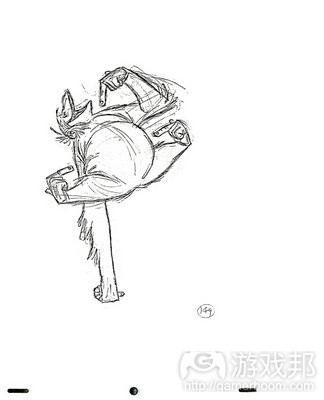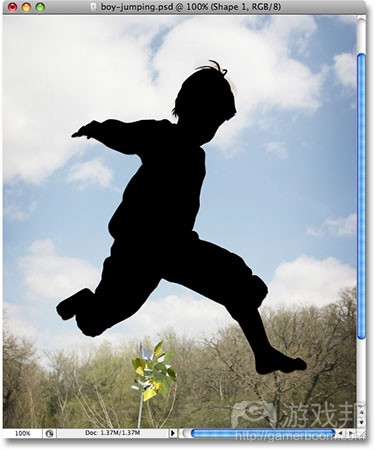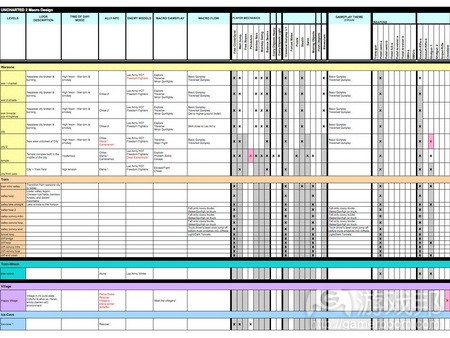以动画设计方式增加游戏设计筹码原则之二
作者:Michael Jungbluth
动作表现力(staging)
动画中的应用
动作表现力要让玩家一目了然地把握游戏世界中最重要的元素。这意味着开发者需知晓自己想要向玩家传递什么信息,让所有内容都配合此焦点。清晰是关键,把握整个情境是根本。在动画中,这意味着屏幕上的所有内容和表现都要着眼于重要元素。(请点击此处阅读本系列第1、第3、第4、第5、第6节内容)
游戏环境、角色姿势、手势及眼神都要围绕重要内容。即便没有话语或声音,玩家依然需要能够立即理解自己的所见,同它们建立联系,因此清晰的分层展现非常关键。
动作表现力也指当角色或情境深层含义有违实况时,你如何从心理角度影响或欺骗玩家。调节摄像头或放置物品会迅速让玩家以微妙方式感受到情感冲击。
游戏设计中的应用
在游戏设计中,你要顾及整个游戏情境。考虑角色所处位置、灯光、升级道具的放置、干扰设置及形状的定义。相比宽阔的开放空间,散落众多残骸的长廊给人什么感觉?若背景是森林,想想盘根错节的树木同高耸红木及年轻幼苗的区别。
理清游戏意图和主题,所有元素都要围绕当前最重要的内容、关卡和叙述故事。然后创建完这些主要目标后,确保情境中的所有元素都围绕此焦点,没有出现相互竞争的情况。
因为当各元素相互竞争时,玩家就会困惑自己要朝何处前进,游戏的目标是什么,基于什么机制,下步要进行什么操作。一旦设计师或游戏未能清楚呈现对玩家的预期,他们就不会继续投入其中。一旦投入感丧失,找回玩家比最初获得他们更加困难。
这并不是说你一次只能操作一个内容。而是指仅向玩家呈现最重要的玩法元素。确保你和玩家都只锁定最适合情境的工具或机制,让其他所有元素和机制都支撑和配合此焦点。这将让元素变得更强大,在游戏世界中更具重要性,能够有组织地同玩家、游戏和设计师创建联系。
深度和空间是体现动作表现力的重要元素。让2D屏幕上的角色看起来沉浸其中的最快方式是让姿势和表现深度富有层次。动画家通过重叠身体部位,把握身体周围的负面空间及轮廓设计实现此目标。他们顾及前景、中间地带和背景,让角色的姿势富有深度,能够凸显焦点。
设计师还需关注核心玩法的深度。你定不希望所有机制在同个情境中都呈现相同层次。进行分层处理,这样有些内容会居于背景,退回玩家的脑海,而有些则出现在前景。
这对在机制中引入新功能或升级内容来说尤其重要。同时还适用习惯性的背景机制。若某些前景元素需要更多关注,它们无需太多细节便能够立即被识别(游戏邦注:例如需要玩家给予更多关注的高级机制)。
判断动作表现力或姿势是否适合动画的最快方式是将其缩减至简单轮廓。这能够带给游戏设计颇多益处。你所要做的工作其实上就是排除白噪音,这能够帮你略过所有细节。其目的是探究设计师能否通过最少信息获悉进展状况,核心内容是否足够强大,能够独立存在,角色或情感是否能够仅凭形状就得到辨认。
这能够以多种方式在游戏设计中得到落实。以粗糙几何原理创建游戏,确保体验过程即便没有艺术元素也非常有趣。在没有任何灯光的情况下,看看自己能否通过调整关卡将玩家带入自己期望的方向。将玩家设置成T姿势,看看自己能否在没有详尽动画的情况下创造期望的情境。
你能否仅基于敌人的速度&时机,在没有短跑、跳跃和装备元素的情况下创造追逐紧张感?你能否通过合理设置T姿势角色的穿梭方式让环境变得栩栩如生?因为若游戏轮廓鲜明,那么玩家在其中所进行的所有操作都会产生一定影响。
若玩家迷失下步操作或丧失兴趣,查看动作表现力模式能够有效探究其中缘由。或由于呈现内容消失,或由于余下体验未能有效配合核心玩法。但若你总是牢记动作表现力模式,总能弄清此刻的焦点,你和玩家就能够继续前进。当所有内容都有层次地呈现时,你所创造内容的重要性就能够通过周围事物体现。
一气呵成 &按关键帧方法(Straight Ahead & Pose to Pose)
动画中的应用
此原则主要涉及设计过程。这是发现和创造表现角色和目的的两种不同方式。
在动画领域,一气呵成指从开端着手,在执行过程中挨个完成每帧画面。这意味着玩家要始终置身角色中,牢记游戏目的。这根本来说就是玩把戏。若不够细心,你的时机会迅速消失,你的操作会缺乏连贯性,角色会丧失真实性。
按关键帧方法是指你预先找到表现或动作的主要节奏,先呈现关键帧的画面。这意味着你锁定的姿势非常强大,你能够迅速把握整个内容的表现方式。只要这些元素确定,你就能够集中着眼于保证中间元素顺畅连接。你需确保所创造和安排的姿势&表达都达到你期望的目标。这里需注意的是,不要让所有要素变得过于按部就班,以致表现过于呆板,缺乏生气。一旦内容变得呆板,其质感就会大打折扣。
就如你所看到的,这二者都不是万能丹,但能够创造真正具有质感的内容。
游戏设计中的应用
在游戏设计中,两种方式能够完美转换。这归根结底其实就是已知&未知,和动画一样,综合运用这两种方式能够让游戏设计获得最佳结果。
纸上规划就运用了一气呵成的方法。你可以先在纸上确定主要机制和解决方案,这样你就能够迅速把握核心,然后再充实中间内容。这非常适合存在较大在线团队的情况,因为这方便向大家呈现规划好的蓝图。同大家分享图表,这样大家就会知道自己的工作职责是什么。立即确定核心节奏、时刻和机制能够促使相关人员中持续关注整体蓝图。若有内容无法在纸上确定,最好的办法就是逐步解决。这就是采用一气呵成方式,这样你就能够测试未知元素,查看其中能够有效运作的内容。这需要大量沟通,能够整体把握创造目标,及成员对各种规则的信任,因为无人能够独立操作。这根本来说就是个即兴表演,所有相关成员都要能够相互理解。这就是所有权及积极、有组织创新内容的诞生地。但同时也是最可能出现失败的地方。这根本来说就是义务表演。此时你无比鲜活,但若是犯下重大错误,你也能够感觉到。
把握各方式的运用时机及二者利弊非常重要。在两种情况中,我们都需要通过优秀技能辨别哪种方式更适合,判断目标是否依然保持一致。若你只在开发中采用一气呵成法,那么团队成员就会觉得自己无足轻重。但若你只采用按关键帧开发策略,你就会迅速发现有些内容与整体脱节了,大家的愿景并不一致。但除管理团队外,这也适用于设计关卡、升级玩家操作或创造更复杂的谜题(游戏邦注:在创建内容时,你的选择不外乎这两种)。
二者的结合能够创造最佳结果。当你遇到未知情况时,最好基于按关键帧方式进行思考,这样你就能够找到有效运作方式。这让你得以学习和试验关键要素,直到你确定其优点所在。然后进行某些一气呵成的设计,将这些定型的动作或功能联系起来。此时你知晓自己的工具和意图,任由它们发挥,任由自己的下意识想法展露出来。
但二者都能进行创新。广泛创新的运作模式是通过思考和讨论把握原始构想。你通过公开讨论解决各种问题。通过一气呵成法,我们能够找到富有意义的迭代创新。正是这些小惊喜让你获得良好感觉。但通过结合这两种方式,你能够保持创新的重要性。(本文为游戏邦/gamerboom.com编译,拒绝任何不保留版权的转载,如需转载请联系:游戏邦)
Adding Weight to Your Game Design Part 3: Staging
by Michael Jungbluth
Staging
Applied to Animation
Staging lets the player know what in the world has the most weight. This means you must know what you want to tell the player, and have everything else frame that focal point. Clarity is the key and being aware of the entire scene is essential. In animation, this means everything on the screen and the performance needs to be designed to keep the focus on what is important.
The environment, the pose of the character, the way they motion with their hands, where they look with their eyes… it all comes together to focus the player’s attention on where and what is important. Even without words or sound the player needs to instantly understand and connect to what they are seeing, and clear staging is the key.
Staging is also how you can psychologically impact or deceive the player when the character or scene’s deeper intent is not what they are being lead to believe. How you tilt a camera or place objects in an environment can quickly make the player feel a sense of emotional weight in a very subtle way.
Applied to Game Design
In game design, think again of the whole scene. Think of where the characters are standing. Think about the lighting. Think about the placement of power-ups. Think about the clutter, and the definition of shapes surrounding the environment. How does a long corridor with lots of debris feel compared to a wide open room? When in a forest, think of the difference of having gnarly, spiney trees vs towering redwoods or young, sprouting saplings.
Figure out your intent and theme, and everything else should lead to what is most important at that moment, to the level, and to the narrative being delivered. Then after you have established those major points, make sure everything else in the scene supports that focus, and does not compete with it.
Because when they compete, that is when you get players confused on where to go, what their objectives are, what a mechanic is used for and what to do next. And once you or your game are no longer clear of what you want with the player, they will lose their investment on where they fit in the world. And once investment is lost, getting the player back is harder than establishing it in the first place.
This isn’t to say you can only have one thing going on at a time. Just stage the most important gameplay elements for the player as the core. Make sure both you and the player are focused on what tool or mechanic best fits the situation, and have all the other elements and mechanics support and frame the focus. This will make that element feel stronger and carry more weight in the world, which will organically connect the player, the game and the designer.
Depth and space are big parts of staging. The quickest way for a character on a 2d screen to look like it is immersed in the world is to layer the poses and performance depth. Animators do this through overlapping body parts, being aware of the negative space throughout and around the body, and making sure their silhouettes read. They think of the foreground, middle ground and background, and pose the character in a way that the depth makes the focus feel all the more supported.
This same attention to depth needs to be defined in your core gameplay. You don’t want to have all your mechanics be at the same depth in the same scene. Layer them, so that some are in the background, receding into the back of the players mind and others are at the forefront.
This is especially key when introducing new features or upgrades to a mechanic. This could also be used for the mechanics that are second nature and always in the background. They can be instantly identified without too many details if you have something in the foreground that requires more attention, such as a high level mechanic that requires more concentration from the player.
The quickest way to see if your staging or pose works on animation is to reduce it to a silhouette. And this is something game design can benefit from a lot. What you are essentially doing is getting rid of the white noise. It helps you get past all of the details. It says, can you read and understand what is going on with just the most minimal of information and is the core strong enough to stand on its own. Is the character or emotion instantly recognizable based solely on the shapes.
This can be done with game design in many ways. Build the game with rough geometry to make sure playing through the area is fun even without the art. Without any lighting, see if you can frame your level in a way that leads player in the direction you want them to go. Keep characters in T-pose to see if you can build the scenario you want without adding elaborate animations.
Can you make a chase feel tense based only on the speed & timing of the enemy, without all the sprints, jumps and tackles? Can you make your environment come alive with the proper placement of T-posed characters pathing through the world? Because if the silhouette of the game is strong, then everything the player does in it will have weight.
If players are getting lost, either on what to do next or just losing interest in general, checking your staging will go a long way to figuring out why that is. Either your performance is being lost or your core gameplay isn’t being framed properly by the rest of the experience. But if you always keep in mind your staging, and always ask what is the focus of the moment, both you and the player will be able to move forward. And when you have everything staged properly, the weight of everything you create will be easily defined by everything else around it.
Adding Weight to Your Game Design Part 4: Straight Ahead & Pose to Pose
Straight Ahead & Pose to Pose
Applied to Animation
This principle is all about process. It is two different methods used for finding and creating the character and purpose in a performance.
In animation terms, straight ahead means just starting at the beginning, and fleshing it out as you go along. You don’t have much of a road map & you are allowing it to come out organically. It means staying in character throughout and keeping the purpose at the front of your mind at all times. It is the ultimate juggling act. Because if you aren’t careful, your timing can quickly fall apart, your actions become inconsistent, and your character loses its truth… its digital weight.
Pose to pose means you are figuring out the major beats of the performance or action up front, and roughing out all the parts at once. This means the poses you focus on are very strong and you can quickly see how the whole thing plays out. Once you get those nailed down, you can then focus on making sure everything in-between links up smoothly. You make sure each pose & each expression you create and time out hit the marks you want. Where you have to be careful is keeping it from becoming so planned that it becomes mechanical and loses the energy of the performance. And once something becomes mechanical, its weight will be questioned.
As you can see, neither are the magic bullet but both offer great solutions when creating something with true weight.
Applied to Game Design
In game design, the two methods translate almost perfectly. What it really comes down to is known vs. unknown, and much like animation, the best results come from using both methods, as the case demands.
Planning on paper is pose to pose. You try to identify the major systems and solutions on the page so that you can get the core in quickly, fleshing out what comes in-between after it is firmly established. This works great when you have a larger team coming online, as it is easier to show everyone the big picture when you have it mapped out. You can keep that map out for everyone to see, and everyone knows where their piece fits. Having those core beats, moments and mechanics instantly keeps the vision alive for everyone involved. But when something can’t be worked out on paper, it can be best just diving in and organically working it out along the way. This is using straight ahead, so that you can play test the unknowns to find out which work. This requires a lot of communication, overall understanding of the creations purpose and trust amongst all the disciplines as no one person can create everything on their own. This is the ultimate jam session, and everyone involved needs to understand the other band members. This is where the most ownership comes from, and where some truly energetic and organic creations can come from. But also where the most chance for failure can happen. It’s essentially performing without a net. You never feel more alive, but if you make a big mistake, you will feel it.
Knowing when to use which method and the strengths and weaknesses of both is the true fundamental. And in both cases, it takes a great leader to identify which method works best and that the vision remains consistent throughout. If you only use pose to pose in your development, the team can feel like a cog in the machine. But if you only have a straight ahead development, you can quickly find that the parts don’t match, and you have mixed visions. But beyond managing teams, this can go for designing a level, upgrading player’s moves, or building more complex puzzles through out the game. Any time you have to create something, you will be somewhere between these two options.
And it really is a mixture of both that yields the best results. When you encounter the unknown it is best to think from pose to pose, so that you can figure out how to make it work. This gives you a chance to learn and experiment on the key aspects, until you feel completely sure of their strength. Then go to town and do some straight ahead game design to link those posed out actions or features. This is the point where you know your tools, you know your intent, and you just let it flow and allow your subconscious to come out and play. When scrum is working as is intended, it embodies this idea perfectly of merging the two methods.
Innovation can be found in both though. For large innovations, it is usually something that tries to be harnessed first by thinking and talking about to grasp the initial kinks. You try to pose it out as best you can to answer your questions. And it is through straight ahead that you can find meaningful iterative innovation. It is those small surprises that appear when you just let yourself go that just feel really good. But it is through using both that you will focus on maintaining the weight of your creations.(Source:gamasutra Part3,Part4)
下一篇:列举独立游戏与众不同的5个原因











































 闽公网安备35020302001549号
闽公网安备35020302001549号